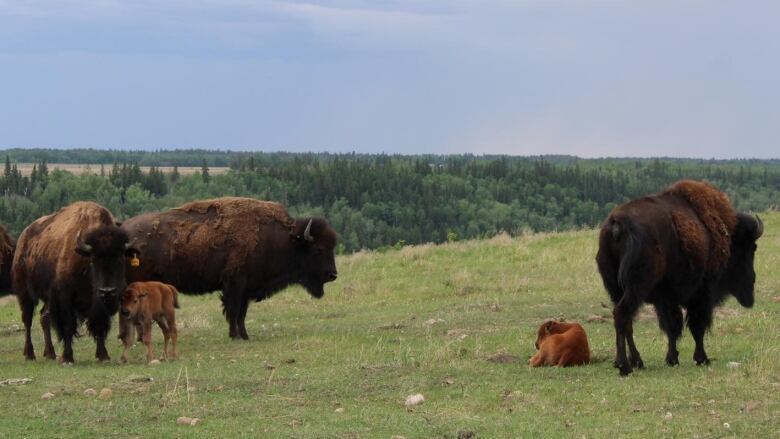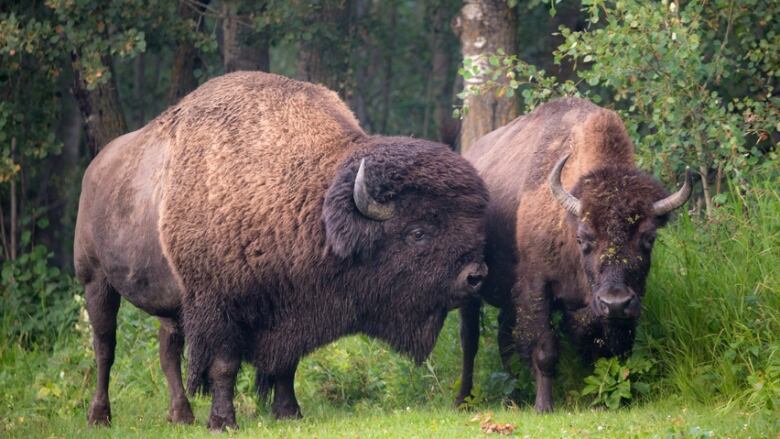Birth of bison calves at Mtis park welcomed as a connection to culture
7 new 'little reds' were born this year at Mtis Crossing in Alberta

Seven fuzzy new additions have joined thebison herd at Mtis Crossing wildlife park this summer.
The bison calves called "little reds" because of their bright colour were recently born to the herd at the parkin Smoky Lake, Alta., about 115 kilometres north of Edmonton.
While staff and visitors celebrated the births, the calves are also important for the broader Mtis community, according to Mtis Crossing CEO Juanita Marois.
"I think the Mtis Nation of Alberta at large is even more excited because we've been talking about having bison for decades," Marois said.
"Now to have our own herd as well as having our own babies is very exciting for all of us."
It was all the more excitingsince prior to 2021, no bison had been born in or lived in the area for 160 years, according to a news release.
Conservation efforts pay off
The little reds are now part of the 20-memberbison herd that was transferred from Alberta's Elk Island National Park to Mtis Crossing in 2022 as part of a conservation effort.
It took roughly two yearsto sort out the details of the transfer,said Dale Kirkland, park superintendent at Elk Island.
"It's a wonderful sight to see in spring and summer, just the little reds on the landscape here," he said.
With the births of the calves, Kirkland said he's grateful to be able to be part of restoring bison to their traditional homelandsatMtis Crossing and other areas.

He said in the past six years, Elk Island National Park hastransferred over 300 bisonto their traditional homelands in 13 Indigenous communities.
Over the past century, the park has transferred over 3,000 bison to re-establishwild herds that were decimated by overhunting and disease in the late 1800s.
Working with Indigenous communities is a key part of conservation, Kirkland added.
Relationship betweenMtisand bison
Marois said the birth of thecalves on traditional lands serves as a reminder of the important relationship between bison and the Mtis.
"When we talk about the buffalo hunt, we talk about the development of ourselves as an Indigenous nation," she said.
"If those buffalo hunters weren't successful, if behind them the women and the youth didn't come and process that buffalo immediately, the families didn't survive through the winter time, and if that hunt wasn't done properly and orderly, people didn't survive the day."
In addition to being a source of food, bison were also central to Mtis economic and political life.
Buffalo was used to make pemmican, aportable mixture of dried meat, fat and berries,which was sold to fur traders and became a staple of the economy, while hunts were governed by laws and principles that are still relevant today.
"The buffalo hunt is the foundation of our governments and we still use many of those principles of the buffalo hunt as we're developing our constitution [and self-government agreement]," Marois said.

Three varieties of bison wood bison, plains bison and white bison along with elk and horses can be seen at Mtis Crossing from the centre's vehicles.
In summer, the bisonroam freely and get their food and water from the land, while in the winter their food is supplemented with hay.
Seeing the massive animals up close (they range from 680to 1100 kilograms) can be an intimidating but also a majestic experience, Marois said.
It also brings a realism to stories about hunting buffalo.
"When you talk about being on a buffalo hunt and riding up beside these and considering there's a thousand of them running across the plains, it's amazing to think that that was how we survived," she said.
Still for the most part, Marois said, "the animals are left to live on the land as they would have."
As they eat and roam, the bison are changing the land.
"We are, as much as possible, trying to re-establish the natural environment that would have been there, after 150 years of farming and then 25 years of more intensive agricultural practices."
Marois said she's hopeful more babies will join the herd next year.












_(720p).jpg)


 OFFICIAL HD MUSIC VIDEO.jpg)
.jpg)



























































































